Labour Force
- Home
- Statistics
- Labour Market
- Labour Market Information
- Labour Force
Key Statistics of Labour Force in Malaysia, March 2021
Labour Force Survey Report, Malaysia, 2020 8 April 2021
Key Statistics of Labour Force in Malaysia, February 2021 8 March 2021
Key Statistics of Labour Force in Malaysia, January 2021 8 February 2021
Key Statistics of Labour Force in Malaysia, December 2020 8 February 2021
Principal Statistics of Labour Force, Malaysia, Fourth Quarter (Q4) 2020 11 January 2021
Key Statistics of Labour Force in Malaysia, November 2020 Show all release archives
Overview
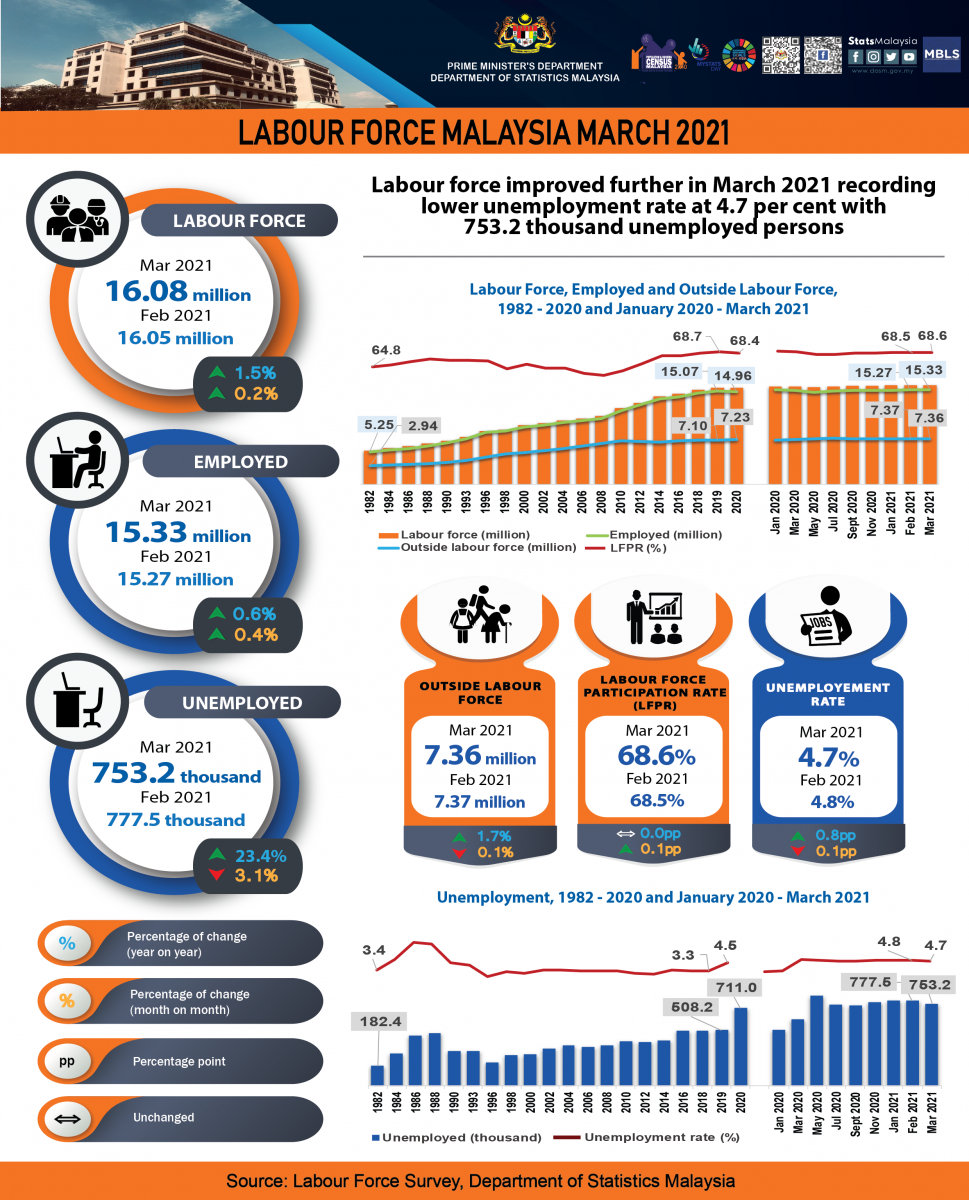

KEY REVIEWS
- The number of employed persons continued to post a positive growth in March 2021 by 0.4 per cent (+58.7 thousand persons) month-on-month to 15.33 million persons (February 2021: 15.27 million persons). The employment-to-population ratio which indicates the ability of an economy to create employment rose by 0.2 per cent to record 65.4 per cent.
- By economic sector, the number of employed persons in Services continued to increase in March 2021 primarily in Wholesale & retail trade; Food and beverages services, Education and Human health & social work activities. Similarly, employed persons in Manufacturing and Construction sectors continued to trend up, whereas employment in Agriculture and Mining & Quarrying sectors remained on a declining trend.
- The employee’s category was added by 76.8 thousand persons or 0.6 per cent to record 11.95 million persons in March (February 2021: 11.87 million persons). This category was the largest composition of employed person with a share of 77.9 per cent. A similar trend was observed in own-account workers encompassed 16.2 per cent, improved by 48.3 thousand persons to register 2.48 million persons in March (February 2021: 2.43 million persons).
- The unemployment rate showed an improvement during the month with a decrease of 0.1 percentage point to record 4.7 per cent as against February 2021. The number of unemployed persons lessened by 24.4 thousand persons or 3.1 per cent to record 753.2 thousand persons (February 2021: 777.5 thousand persons).
- The number of labour force went up by 0.2 per cent (+34.3 thousand persons) to 16.08 million persons (February 2021: 16.05 million persons). The labour force participation rate (LFPR) changed little by 0.1 percentage point to post 68.6 per cent in March 2021 (February 2021: 68.5%)
- March 2021 observed the number of outside labour force reduced by 7.6 thousand persons to 7.36 million persons (February 2021: 7.37 million persons). Schooling/ training was the largest composition of outside labour force with 44.9 per cent or 3.31 million persons and followed by housework/ family responsibilities with 40.2 per cent or 2.96 million persons.
- The rising number of daily COVID-19 cases in Malaysia had prompted the implementation of MCO and Restricted MCO in certain states and targeted areas such as Kelantan, Sabah, Selangor and W.P. Kuala Lumpur in May 2021. These signalled that the labour force may face some challenges in the forthcoming months. However, with the encouraging labour market improvement observed in the first quarter of 2021, it is hope that the labour market will continue its recovery momentum albeit at a moderate pace.
MALAYSIA’S LABOUR FORCE IMPROVED FURTHER IN MARCH 2021
March 2021 marked one year after the first Movement Control Order (MCO) was implemented beginning on 18 March 2020 prompting a new norm since the spread of COVID-19 in Malaysia. Unlike MCO 1.0 where most economic activities as well as national and interstate borders were closed, March this year saw most states were in Recovery MCO while several others were in Conditional MCO namely Selangor, Johor, Kelantan, W.P. Kuala Lumpur and Pulau Pinang starting from 2 March 2021.
In spite of the implementation of various stages of MCO across the nation, economic activities were permitted to continue operated in compliance of strict standard operating procedures (SOP). Since 1 March, preschools and primary schools had reopened; thereby allowing education-related businesses such as school canteens and bus services to also reopen. Moreover, social events such as wedding receptions, reunions and gatherings were allowed with restrictions based on the size of the premises and depending on the stage of the MCO. Hence, it was observed that the labour force situation in March 2021 continued to improve month-on-month with an increase in employment while unemployment posted a larger decreased.
The short-term economic indicators in March 2021 showed that both exports and imports as well as trade surplus further strengthened by recording a positive double-digit growth with 19.8 per cent, 15.9 per cent and 35.1 per cent respectively.
Further recovery in Malaysia labour force may be more certain with the resumptions of most business activities coupled with the expansion of COVID-19 vaccination programme to a larger community. Nevertheless, this positive momentum will subject to the uncertainties in the country’s health condition and subsequently the economic performance.
The Labour Force Report for March 2021 describes the labour supply situation as the country entered the thirteenth month of various phases MCO. The report will elaborate on the month-on-month changes to examine the immediate effects of the MCO to contain the spread of COVID-19. Users are advised to interpret the monthly statistics with caution since they are non-seasonally adjusted. In addition, annual changes from the same month of the previous year are also reported.
Employed persons continued to post a positive growth in March 2021
The number of employed persons continued to post a positive growth in March 2021 by 0.4 per cent (+58.7 thousand persons) month-on-month to 15.33 million persons (February 2021: 15.27 million persons). Since April 2020, the number of employed persons was on a year-on-year declining trend but for the first time after eleven consecutive months, the number of employed persons registered a positive year-on-year growth of 0.6 per cent (+96.9 thousand persons).
By economic sector, the number of employed persons in Services continued to increase in March 2021 primarily in Wholesale & retail trade; Food and beverages services, Education and Human health & social work activities. Similarly, employed persons in Manufacturing and Construction sectors continued to trend up, whereas employment in Agriculture and Mining & Quarrying sectors were remained on a declining trend.
During the month, the employment-to-population ratio which indicates the ability of an economy to create employment rose by 0.2 per cent to record 65.4 per cent. Nevertheless, year-on-year, the ratio was lowered by 0.6 percentage points as compared to 66.0 per cent in March 2020. [Chart 1]
Chart 1: Employed persons and employment-to-population ratio, January 2018 - March 2021
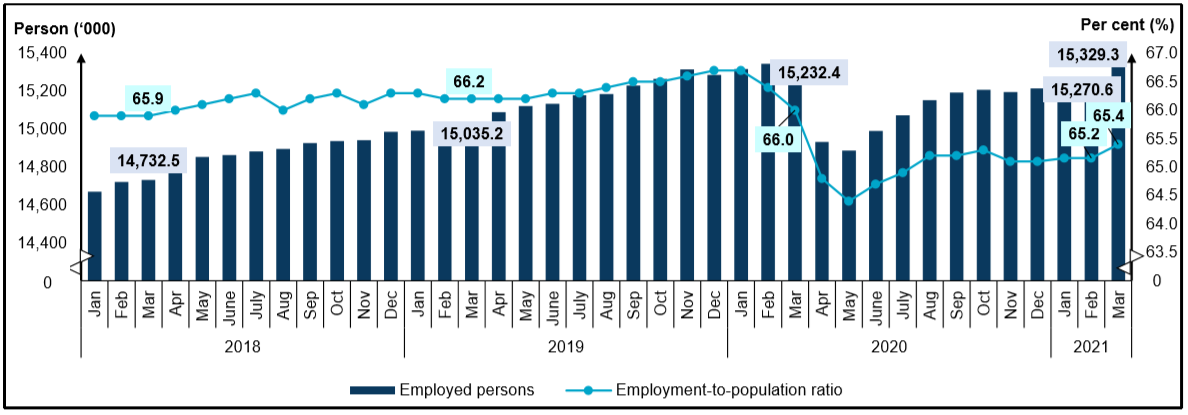
The employee’s category was added by 76.8 thousand persons or 0.6 per cent to record 11.95 million persons in March (February 2021: 11.87 million persons). This category was the largest composition of employed person with a share of 77.9 per cent. A similar trend was observed in own-account workers encompassed 16.2 per cent, improved by 48.3 thousand persons to register 2.48 million persons in March (February 2021: 2.43 million persons). [Chart 2]
This group comprised mostly of daily income earners working as small business operators such as small retailers; hawkers; sellers in markets and stalls as well as smallholders. A continuous improvement in own-account workers might partially supported by the financial assistance provided by the government under the Pakej Bantuan Perlindungan Ekonomi dan Rakyat Malaysia (PERMAI) through the Additional Geran Khas Prihatin (GKP) for micro Small Mediaum Enterprise (SME). The total of GKP recipients including GKP 1.0, GKP 2.0 and additional GKP were almost 900,000 SMEs with a total of 3.08 billion .
Chart 2: Employed person by status of employment, February and March 2021
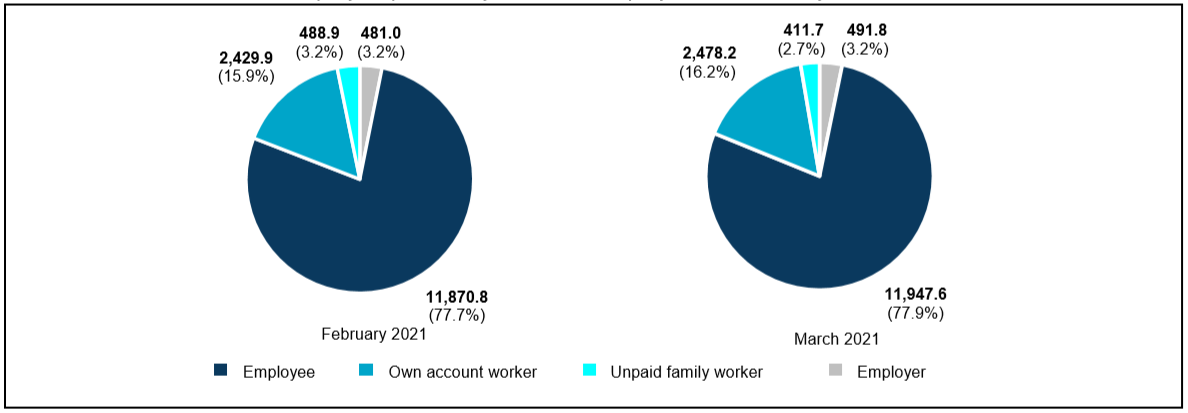
In March 2021, the number of employed persons who were temporarily not working continued to trend down to 121.0 thousand persons (February 2021: 150.8 thousand persons) reflecting the continuous resumption of almost all business activities during the month. Similarly, the number of employed persons who were temporarily not working posted a decreased year-on-year of 1.8 million persons (-93.6%) as compared to 1.9 million persons in March 2020 which was during the first pandemic strike in the country. This group of persons, who were most likely not able to work was not categorised as unemployed as they had work to return to.
Unemployment rate showed an improvement during the month
The unemployment rate showed an improvement during the month with a decrease of 0.1 percentage point to record 4.7 per cent as against February 2021. The number of unemployed persons lessened by 24.4 thousand persons or 3.1 per cent to record 753.2 thousand persons (February 2021: 777.5 thousand persons).
In the meantime, the unemployment rate for March 2021 edged up by 0.8 percentage points from 3.9 per cent in March 2020. The number of unemployed persons were added by 142.7 thousand persons (March 2020: 610.5 thousand persons). [Chart 3]
Chart 3: Unemployed persons and unemployment rate, 1982 - 2020 and January 2020 - March 2021
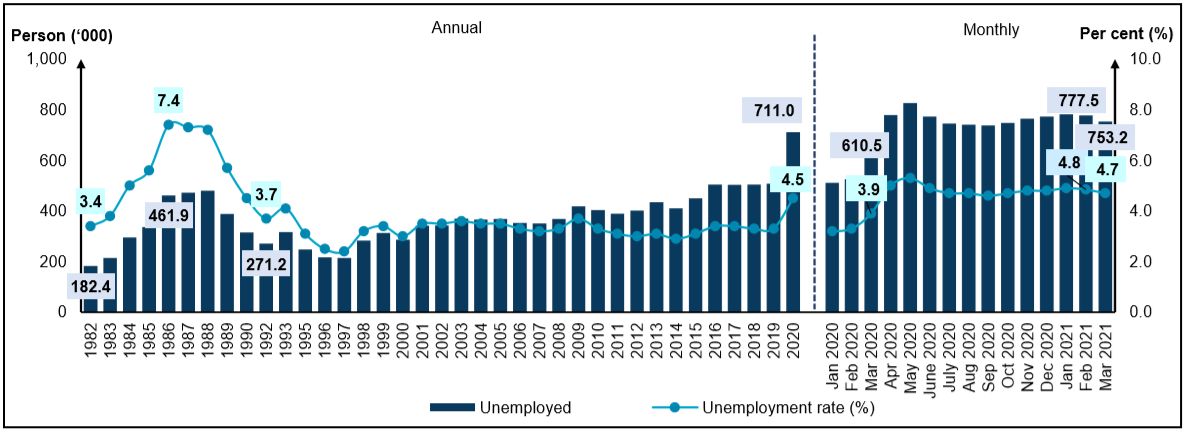
By category, actively unemployed which is defined as those who were available for work and were actively seeking job was downed by 20.5 thousand persons (-3.2%) to record 626.9 thousand persons (February 2021: 647.4 thousand persons). More than half of the actively unemployed persons were categorised as those who were unemployed for less than three months (51.1%), while 10.9 per cent of actively unemployed were in long-term unemployment2 of more than a year. [Chart 4]
Similarly, the number of inactively unemployed who believed that there were no jobs available declined by 3.0 per cent or equivalent to 3.9 thousand persons to 126.3 thousand persons (February 2021: 130.1 thousand persons).
Chart 4: Unemployed category and duration of unemployment, February and March 2021
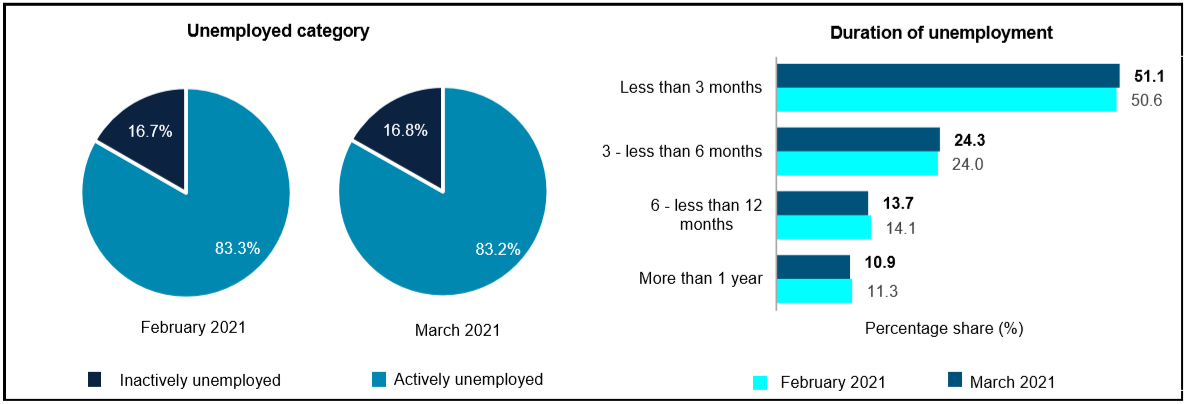
In March 2021, the youth unemployment rate for aged 15 to 24 years also witnessed a decrease of 0.5 percentage points to register 13.4 per cent as compared to the previous month. The number of unemployed youths decreased to 321.1 thousand persons (-26.5 thousand persons) from 347.6 thousand persons recorded in February 2021. On the contrary, the youth unemployment rate for aged 15 to 30 years changed little over the month but higher by 0.1 percentage point than in February 2021 to record 9.3 per cent. [Chart 5]
Chart 5: Unemployment rate by selected age groups, 1982 - 2020 and January 2020 - March 2021
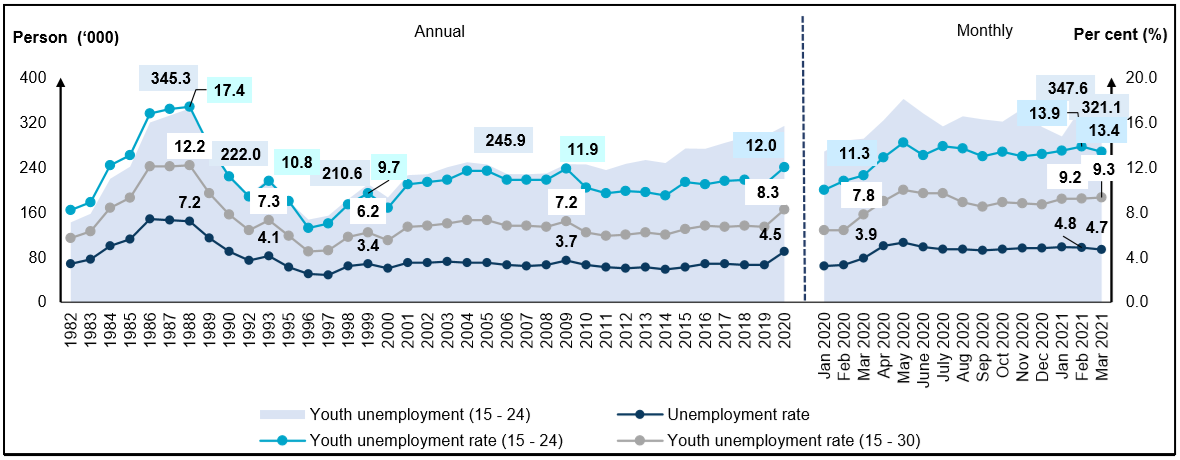
LFPR changed little by 0.1 percentage point to post 68.6 per cent in March 2021
The number of labour force went up by 0.2 per cent (+34.3 thousand persons) to 16.08 million persons (February 2021: 16.05 million persons). The labour force participation rate (LFPR) changed little by 0.1 percentage point to post 68.6 per cent in March 2021 (February 2021: 68.5%).
On year-on-year basis, the number of labour force improved by 239.6 thousand persons as against the same month of the preceding year (March 2020: 15.84 million persons) whereas the LFPR was unchanged at 68.6 per cent. [Chart 6]
Chart 6: Labour force and LFPR, 1982 – 2020 and January 2020 - March 2021
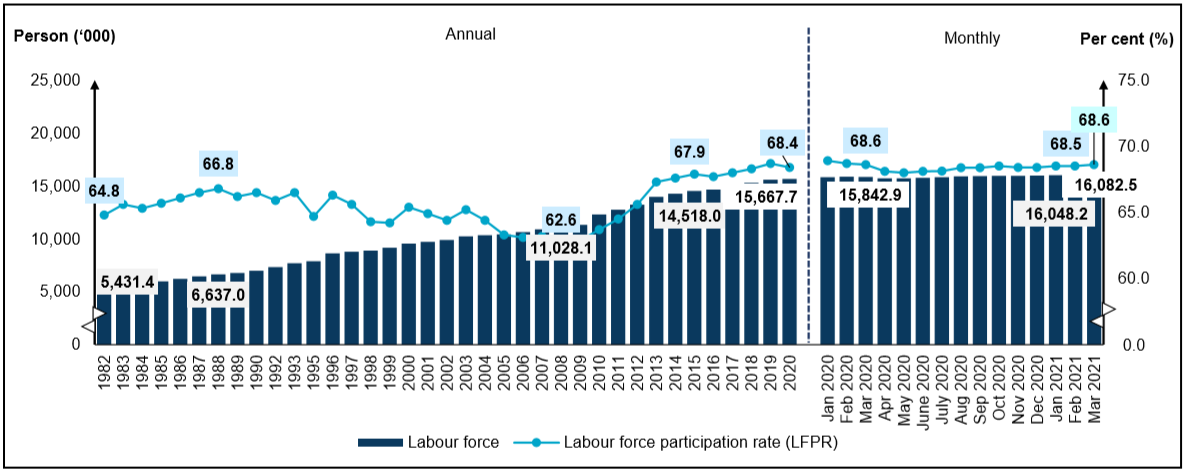
In terms of LFPR by sex, male LFPR stood at 81.0 per cent while female LFPR increased by 0.1 percentage point to 55.2 per cent. Male labour force heightened by 0.2 per cent (+22.6 thousand persons) to record 9.84 million persons (February 2021: 9.82 million persons). Likewise, female labour force was added by 11.8 thousand persons than February 2021 to 6.24 million persons. Year-on-year, male LFPR posted an addition of 0.3 percentage points whereas female LFPR dropped by 0.3 percentage points. [Chart 7]
Chart 7: Labour force and LFPR by sex, 1982 - 2020 and January 2020 – March 2021
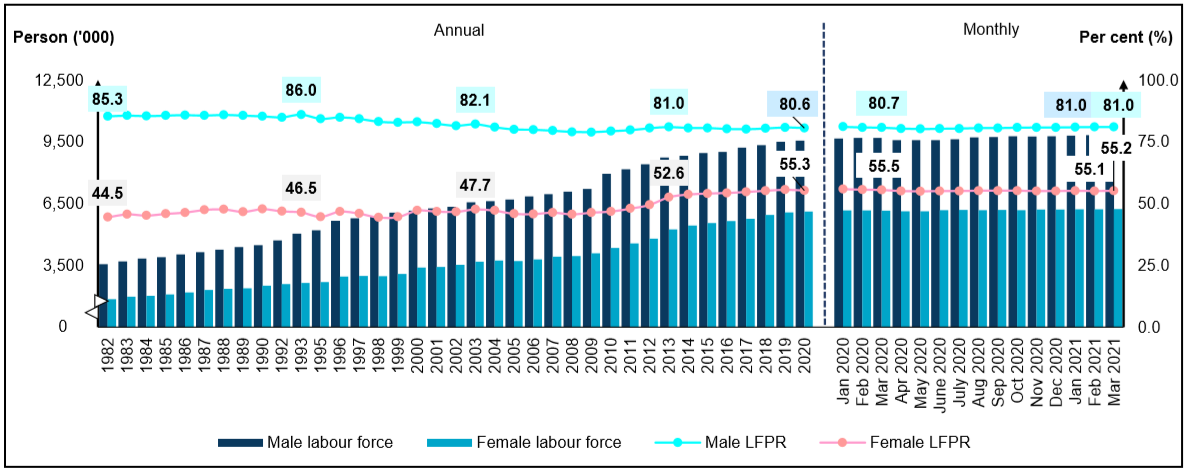
Schooling/ training was the largest composition of outside labour force
March 2021 observed the number of outside labour force reduced by 7.6 thousand persons to 7.36 million persons (February 2021: 7.37 million persons). However, year-on-year, this number was rose by 1.7 per cent (+124.0 thousand persons). Schooling/ training was the largest composition of outside labour force with 44.9 per cent or 3.31 million persons and followed by housework/ family responsibilities with 40.2 per cent or 2.96 million persons. [Chart 8]
Chart 8: Share of outside labour force by reasons for not seeking work, February and March 2021
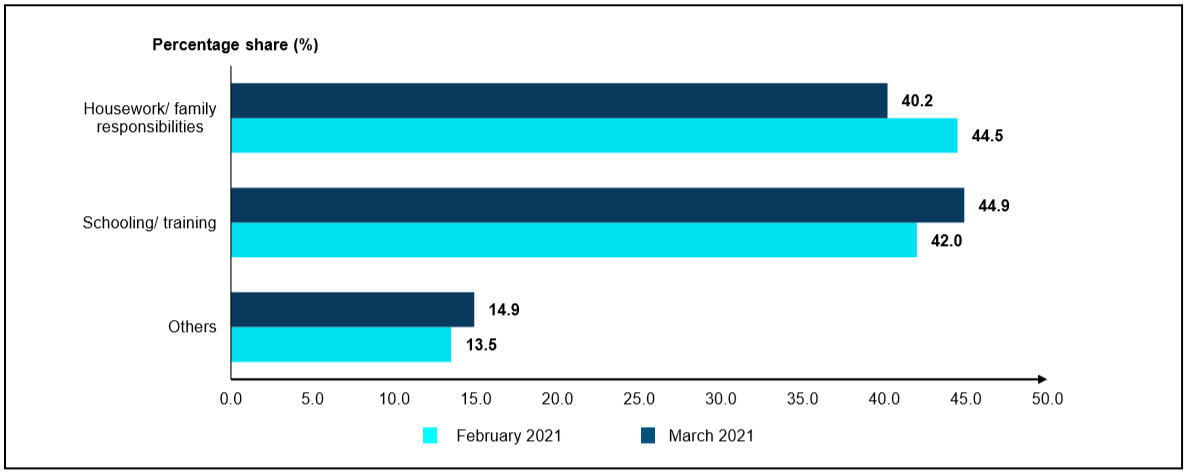
GOVERNMENT’S INITIATIVES
As of the closing date of the Wage Subsidy Programme (PSU) 1.0 on 26 February 2021, a total of 322,177 employers and 2.64 million registered employees had been facilitated through this programme under PRIHATIN and PENJANA. As of 12 March 2021, a total of RM12.84 billion value of the approved wage subsidy applications had been reached through PSU 1.0. Meanwhile, a total of RM1.09 billion of PSU 2.0 had been disseminated to 72,531 employers, allowing them to continue operating and maintaining 619,821 employees. Moreover, through the Reskilling and Upskilling Programme, there were 137,075 participants had been approved to participate in the course offered by various ministries and government agencies listed.
To assist workers who have lost their jobs, through the Employment Insurance System under Social Security Organisation (SOCSO) provided RM85.96 million in financial assistance which includes the increased of Job Seeker Allowance as announced in the Budget 2021 to over 18,000 workers who had lost their jobs as of 14 March 2021. Besides, as of 15 March 2021, a total of 2,586 health employees had been hired to strengthen the public health system in order to contain the COVID-19 pandemic, including Science Officers, Diagnostic Radiologists, Medical Laboratory Technologists, Assistant Environmental Health Officers, Assistant Medical Officers, and Nurses as well as 3,591 contract health workers were appointed to meet immediate staff needs following a rise in COVID-19 cases.
To empower the SME businesses, a total of 7,205 loan applications had been approved totalling RM1.36 billion under the PENJANA SME Financing as of 13 March 2021. Through the SMEs Soft Loans funds, a total of RM11.75 billion applications were approved by local banks, benefitting 24,819 SMEs as of 12 March 2021 which comprise of Special Relief Facility (SRF), Automation & Digitalisation Facility (ADF), All-Economic Sector Facility (AES) and Agrofood Facility (AF) funds. Furthermore, under the Bumiputera Relief Financing (BRF) which particularly allocated for Bumiputera SMEs which were impacted by the COVID-19, a total fund of RM193.1 million had been distributed to 670 SMEs. Additionally, under the Agrobank Micro Credit Financing, a total of 9,400 Agricultural Micro SMEs were aided involving RM107.23 million to support the Agriculture and Food Industry.
Thus, with a continuous resumption of economic activity coupled with various assistances of the government’s initiatives to ease the burden of people, business and economy, these might lead the recovery of the labour market to be back on track and thus strengthening the labour market momentum.
LOOKING AHEAD
From April 2021 onwards saw daily COVID-19 new cases in Malaysia’s intensified, exceeding 3,000 cases towards the end of the month. However, the execution of the vaccination programme which had entered the second phase together with the resumption of more economic activities might increase confidence of businesses and public to move forward while practising the new norm and following the SOPs. The continuous reopening of most business operations has stimulated the demand in the economy as well as open up job opportunities. These could partly contribute to the expansion in the labour market.
To further ease the burden of businesses, the government through the Strategic Programme to Empower the People and Economy (PEMERKASA) provides discount of electricity bill to six tourism-related industries throughout the country namely hotel operators, theme park, shopping centre, local airlines office and travel & tourism agency which took effect starting on 1 April until 30 June 2021. On top of that, almost 1.2 million SMEs is expected to benefit when the government announced that SMEs who never received the additional GKP 3.0 may submit a new application. To further strengthen the public health system, the government will be hiring another 1,005 contract health workers which will create and increase job opportunities in the health sectors.
The rising number of daily COVID-19 cases in Malaysia had prompted the implementation of MCO and Restricted MCO in certain states and targeted areas such as Kelantan, Sabah, Selangor and W.P. Kuala Lumpur in May 2021. These signalled that the labour force may face some challenges in the forthcoming months. However, with the encouraging labour market improvement observed in the first quarter of 2021, it is hope that the labour market will continue its recovery momentum albeit at a moderate pace
TECHNICAL NOTES
This information is derived from the Labour Force Survey (LFS) which was conducted to collect information on the structure and distribution of labour force, employment and unemployment.
The survey population cover persons who live in private living quarters and excludes persons residing in institutions such as hotels, hostels, hospitals, prisons, boarding houses and workers residing in construction work site.
The survey comprises of the economically active and inactive population. To measure the economically active population, the LFS uses the age limit of 15 to 64 years. The economically active population comprises of those employed and unemployed whereas those who are inactive is classified as outside the labour force.
LFS uses the actual status approach, where a person is classified on the basis of his labour force activity during the reference week.
- Labour force refers to those who, during the reference week are in the 15 to 64 years (in completed years at last birthday) and who are either employed or unemployed.
- Employed refers to all persons who, at any time during the reference week worked at least one hour for pay, profit or family gain (as an employer, employee, own-account worker or unpaid family worker). Also considered as employed are persons who did not work during the reference week because of illness, injury, bad weather, leave, labour dispute and social or religious reasons but had a job, farm, enterprise or other family enterprise to return to. Also included are those on temporary lay-off with pay who would definitely be called back to work.
- Unemployed
Unemployed refers to those who do not have a job but are interested to work. There are two groups of unemployed that is the actively unemployed and inactively unemployed.
- Outside Labour Force
All persons not classified as employed or unemployed as stated above are classified as outside labour force. Includes housewives, students (including those going for further studies), retired, disabled persons and those not interested in looking for a job.
- Labour Force Participation Rate
The economic activity of a population depends on the demographic characteristics of that population. The proportion of economically active population, therefore, differs between sub-groups of that population. These variations are measured by specific activity rates termed as labour force participation rate. Labour force participation rate is defined as the ratio of the labour force to the working age population (15 to 64 years), expressed as percentage.
- Unemployment rate is the proportion of unemployed population to the total population in labour force. This rate measures the percentage of unemployed population in the labour force.
Population Benchmarks
Population by characteristics of age group, ethnicity and state were used as benchmarks to produce labour statistics.
Starting with the monthly release of the Principal Statistics of Labour Force, Malaysia, January 2016, the principal statistics of labour is estimated based on the current population estimates as compared to the previous series which used population projections based on the Population and Housing Census of Malaysia, 2010. This rebase is to obtain statistics that is more consistent with current population structure.
The full publication of the Labour Force Report, March 2021. This report is accessible and downloadable through the application eStatistik Portal, Free Download
For more details, please refer to the Department’s portal: www.dosm.gov.my
Released By:
DATO' SRI DR. MOHD UZIR MAHIDIN
CHIEF STATISTICIAN MALAYSIA
DEPARTMENT OF STATISTICS, MALAYSIA


7 May 2021
Contact person:
Mohd Yusrizal bin Ab. Razak
Public Relation Officer
Strategic Communication and International Division
Department of Statistics, Malaysia
Tel : +603-8885 7942
Fax : +603-8888 9248
Email : yusrizal.razak@dosm.gov.my
Subscribe
Newsletter
Subscribe to our newsletter and stay updated
For interviews, press statement and clarification to the media, contact:
Baharudin Mohamad
Public Relation Officer
Email: baharudin[at]dosm.gov.my
Phone: 03 8885 7942
Not found what you looking for? Request data from us, through
Go to eStatistik
email to data[at]dosm.gov.my
call 03 8885 7128 (data request)









